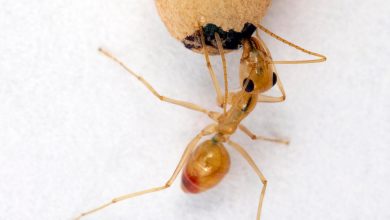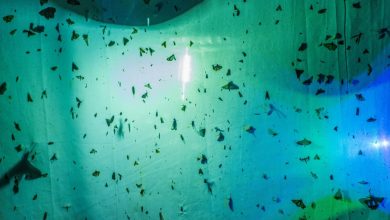How an Ancient Fish’s Skull Got Filled With Fossilized Feces

It’s a dubious distinction in the fossil record: For the first time, a vertebrate has been found with fecal pellets where it’s brain once was.
The fossilized animal was Astroscopus countermani, an extinct fish first described as a separate species in 2011 in Maryland. Also known as a stargazer because its eyes were on top of its head, it was the earliest known member of its family and its genus, which still hunts prey on seafloors all over the world. But approximately 7.5 million to 10.5 million years ago in the Miocene era, scientists suspect this stargazer specimen, which may have been the size of today’s trout, died and its braincase might have been infiltrated by polychaetes or another kind of annelid worm. The creatures may have scavenged the dead fish’s brain, leaving a profuse amount of excrement in their wake.
“This,” said Stephen J. Godfrey, curator of paleontology at the Calvert Marine Museum in Maryland and an author of the study, “was an overachieving worm or worms that burrowed into this little fish!”
Although the stargazer fossil was not a new find, the authors more recently were able to use improved technology to peer inside both the braincase and the fossilized pellets without destroying either. In a paper published in January in the journal Rivista Italiana di Paleontologia e Stratigrafia, the scientists describe using a spectroscopic device to confirm the calcium and phosphate signatures of coprolites — fossilized feces — in the fish’s braincase.
It’s remarkable, Dr. Godfrey says, that a fish so small survived fossilization. But it’s equally remarkable that the tightly-packed coprolites within its braincase were also preserved. It means that no other ancient scavenger for whom fecal pellets would have meant lunch followed behind those worms.
The Calvert Cliffs where the fossil was found stretch 35 miles along the coast of Maryland. Well-known for its voluminous and diverse fossil content, the site has so far produced fossils of 650 different ancient organisms. They include evidence of creatures burrowing into fossilized remains, shark fossils with shark bite marks on them, shark-bitten coprolites, and whale fossils that indicate they were scavenged. John Nance, a co-author and paleontology collections manager at the Calvert Marine Museum, has found numerous trace fossils at the beaches beside these cliffs, many of which were discussed in the recent paper.
But the micro-coprolites described in this paper have proved particularly enticing for study. Dr. Godfrey and his co-authors noted their uniform shape and size. Similar fecal pellets have been found much deeper in the fossil record, including the heads of trilobites more than 450 million year old.
“We do not know the identity of the producers of these pellets,” said Alberto Collareta, a co-author and paleontologist at the University of Pisa, “but we know that their behavior has proved quite successful.” In other words, the same type and shape of micro-coprolites have been found in similar tight spaces for hundreds of millions of years.
Although large fossils get considerable attention in paleontology, “fossils of tiny organisms, however, often have much more to say,” said Aline Ghilardi, a paleontology professor at the Federal University of Rio Grande do Norte in Brazil who was not involved in the research.
She says that smaller creatures and what they leave behind — burrows or bodily waste — can provide detailed stories about environmental changes over time.
“Each type of fossil has a different story to tell, and these stories complement each other, helping us to reconstruct a more accurate picture of the past,” she said. “Paleontologists need all these pieces to reconstruct the history of life.”





